A Senate Appropriations Committee report says Aeronav should immediately restore the 17-day advance availability of digital charts to the public on its website, and further demands to see a business case supporting Aeronav’s claims that it needs to charge fees for digital charts. “Sales of paper products have fallen but the FAA should not view the sale of digital products simply as a convenient source of revenue to compensate for the loss of revenue,” the report said.
The crew of a United Express Embraer 145 called controllers at Denver International Airport with a report of smoke in the cockpit, but the controller apparently misheard the aircraft’s flight number and initially dismissed the call’s urgency. Controllers at the airport have reportedly become leery of false transmissions initiated by people on the ground. It was only after the aircraft landed and the crew called again that the controller alerted rescue crews. By that time, five minutes had elapsed since the initial emergency call. Once on scene, firefighters extinguished a fire behind the instrument panel. The NTSB has turned over the investigation to the FAA.
In a 5-to-3 decision, the Supreme Court overturned a ruling by a California court and said the government could be held liable only for financial damages, such as losses and expenses, because the Social Security Administration gave confidential medical information about a pilot to the FAA. Dissenting justices wrote that the majority view makes it easy for the government to invade individual privacy without consequences.
The Air Force racked up an extra $1 billion in costs last year due to rising oil prices. To save fuel, pilots of some of the AF’s 4700+ aircraft are being ordered to fly higher and slower on some missions. According to the AF, diplomatic efforts have created more direct routes of travel and last year saved $2.4 million. Additional efforts include engine updates, taxiing with some engines shut down and no longer carrying “pet rocks”—large concrete blocks that simulate heavy-equipment cargo.
Aviation historians and warbird enthusiasts are drooling at the discovery of at least a dozen perfectly preserved, brand-new, Spitfire Mark 14s buried in Myanmar (formerly Burma). The aircraft were buried at the end of WWII. Their story and final location were traced by British farmer David Cundall after spending 15 years and $200,000 of his own money. The appear to have been buried in their original packing crates. British Prime Minister David Cameron is expected to help Cundall seal the deal.
Well, not exactly “over.” Slovene pilot Matevz Lenarcic took his modified Pipistrel Virus to 29,344 feet above the Himalayas—not directly overflying the summit of Mt. Everest, but reaching an altitude about 300 feet above that highest peak. According to Pipistrel’s news release, the Nepali government rescinded permission the day before the flight, “but Matevz did it anyway, so the news were only released a day later to prevent him from having any trouble with Nepal authorities.” By the time it was announced, Matevz was “already safely in India.”
Cirrus Jet back on track with funding to complete development … Cessna Skycatcher sales on hold in Europe due to certification snafu … Former FAA safety inspector gets jail time for doing for-pay checkrides on his days off … Air Force puts up http://seeandavoid.org/ to show the status of special-use airspace and historical locations of near-mid-air collisions … Garmin expands European VFR and Safetaxi charts … Scaled Composites so desperate for workers they hold an open house … Tecnam P2010 high-wing, four-seat single makes first flight … WingX for iPad now shows obstacles and (with the right additional equipment) traffic … For breaking news in general aviation, log on to www.avweb.com.




